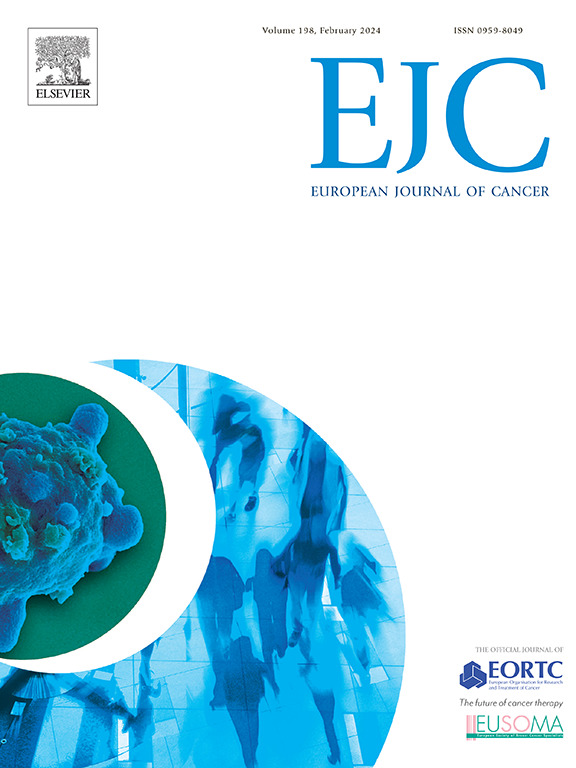同步转移性前列腺癌男性患者的流行病学--26 年全国时间分析
IF 7.1
1区 医学
Q1 ONCOLOGY
引用次数: 0
摘要
背景同步转移性前列腺癌(mHSPC)男性患者的成像模式不断发展、认知度提高以及前列腺特异性抗原检测有望延长患者的生存期。在此,我们分析了丹麦确诊为同步转移性前列腺癌的男性患者的生存趋势。方法我们纳入了1995年1月1日至2021年12月31日期间丹麦确诊为mHSPC的所有男性患者(N = 12,017)。随访至 2022 年 12 月 31 日。中位死亡时间用卡普兰-梅耶尔法计算,前列腺癌每日历年的3年死亡风险用Aalen-Johansen估算器估算,从诊断时间算起。1995年和2018年确诊的男性中位生存期分别从1.7年(IQR:1-3-2-0)增至3.8年(IQR:3-3-4-2)(p <0-001),之后未达到中位生存期。确诊三年后的前列腺癌特异性死亡率从 1995 年的 66 %(95 %CI:60-72)降至 2019 年的 28 %(95 %CI:25-32)(p < 0-001)。从1995-1999年到2015-2021年,65岁男性的中位总生存期从1-7年(IQR:0-8-3-7)延长至4-5年(IQR:2-4-未达到;p< 0-001),74岁以上男性的中位总生存期从1-5年(IQR:0-7-2-9)延长至3-1年(IQR:1-6-5-7;p< 0.001)。释义生存期的延长表明,除其他因素外,新型疗法的实施很可能在临床试验环境之外具有疗效。不过,大多数确诊为同步转移性前列腺癌的男性将死于前列腺癌。因此,延长生命和针对不同年龄段进行治疗试验的必要性仍然是显而易见的。本文章由计算机程序翻译,如有差异,请以英文原文为准。
Epidemiology of men with synchronous metastatic prostate cancer diagnosis – A nationwide 26-year temporal analysis
Background
Evolving imaging modalities, increased awareness, and prostate-specific antigen testing in men with synchronous metastatic prostate cancer (mHSPC) are expected to have prolonged survival. Here we analyze trends in survival among men diagnosed with synchronous metastatic prostate cancer in Denmark.
Methods
Here, we included all men diagnosed with mHSPC (N = 12,017) in Denmark between January 1st, 1995, and December 31st, 2021. Men were followed until December 31st, 2022. Median time to death was calculated by the Kaplan Meier method and the 3-year risk of prostate cancer death per calendar year was estimated by the Aalen-Johansen estimator from time of diagnosis.
Findings
Median follow-up was 9 years (IQR: 4–15), from 2015 59 % of the men with mHSPC had treatment beyond androgen depletion therapy. Median survival increased from 1.7 years (IQR: 1·3–2·0) to 3.8 years (IQR: 3·3–4·2) in men diagnosed in 1995 and 2018, respectively (p < 0·001), after which median survival was not reached. The prostate cancer-specific mortality three years after diagnosis decreased from 66 % (95 %CI: 60–72) in 1995 to 28 % (95 %CI: 25–32) in 2019 (p < 0·001). From the period 1995–1999 to 2015–2021 median overall survival increased from 1·7 years (IQR: 0·8–3·7) to 4·5 years (IQR: 2·4-not reached; p < 0·001) in men age < 65 years and from 1·5 years (IQR: 0·7–2·9) to 3·1 years (IQR: 1·6–5·7; p < 0.001) in men older than 74 years at diagnosis.
Interpretation
The improved survival suggests that, among other contributing factors, implementing novel therapies has likely been efficacious outside the clinical trial setting. Still, most men diagnosed with synchronous metastatic prostate cancer will die of prostate cancer. As such the need for life-prolonging and age-tailored treatment trials remains evident.
求助全文
通过发布文献求助,成功后即可免费获取论文全文。
去求助
来源期刊

European Journal of Cancer
医学-肿瘤学
CiteScore
11.50
自引率
4.80%
发文量
953
审稿时长
23 days
期刊介绍:
The European Journal of Cancer (EJC) serves as a comprehensive platform integrating preclinical, digital, translational, and clinical research across the spectrum of cancer. From epidemiology, carcinogenesis, and biology to groundbreaking innovations in cancer treatment and patient care, the journal covers a wide array of topics. We publish original research, reviews, previews, editorial comments, and correspondence, fostering dialogue and advancement in the fight against cancer. Join us in our mission to drive progress and improve outcomes in cancer research and patient care.
 求助内容:
求助内容: 应助结果提醒方式:
应助结果提醒方式:


